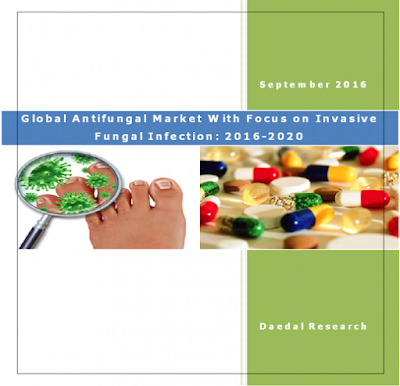The report titled “Global Antifungal Market With Focus onInvasive Fungal Infections: 2016-2020” provides an in-depth analysis of the
global antifungal market with detailed analysis of market size on the basis of
value along with the comprehensive examination of each of the segments of the
market, namely, Azole, Echinocandins and Polyene.
The report analysis the invasive fungal infection market
extensively with the market size, in terms of value along with the market
segments and the major products in the market. This section also provides
information about the regional market share of the global invasive fungal
infection market. The report provides detailed regional analysis of the United
States, Europe and Latin America. The regional analysis of the antifungal
market includes market size by value along with the geographic overview of the
market in the concerned region.
The report also assesses the key opportunities in the
market and outlines the factors that are and will be driving the growth of the
industry. Growth of the overall global antifungal market has also been
forecasted for the period 2016-2020, taking into consideration the previous
growth patterns, the growth drivers and the current and future trends. The
competition in the global antifungal market is stiff and dominated by the big
players like Pfizer. Further, key players of the market, Merck and Scynexis are
also profiled with their financial information and respective business
strategies.
Regional Coverage
United States
Europe
Latin America
Company Coverage
Pfizer, Inc.
Merck Co., Inc.
Scynexis, Inc.
Executive Summary
The global antifungal market witnessed an upsurge at a
significant CAGR during 2012-2015 and projections are made that the market
would rise in the next five years i.e. 2016-2020 tremendously. The market is
spread across the globe with the United States and Europe dominating the
market, while Asia-Pacific and Latin America market are the fastest growing
markets.
The antifungal market can be segmented on the basis of
types of drugs into Polyene, Azole and Echinocandins. The Azole class of
antifungals dominates the market followed, by Echinocandins and Polyene. Azoles
are broadly categorized as Voricanazole, Imidazole, Triazole and Thiazoles. Of
which, Voricanazole govern the market. Echinocandins antifungal class is
subjugated by Caspofungin, while other antifungals include Micafungin, and
Anidulafungin. The Polyene antifungal agents include Amphotericin B, Nystatin,
and Natamycin. Though, Amphotericin B is the only widely used agent in the
market.
The fungal infections do not usually result in severe
ailment, but in people with weak immune system, minor fungal infections can
move in the bloodstreams and conquer critical organs leading to the damage,
called as invasive fungal infection. The global market for the invasive fungal
infection increased significantly during 2010-2015 and is expected to upsurge
further.
The major growth drivers for the global antifungal market
are: the rise in the incidences of fungal infection, aging population and
unhygienic conditions all over the world. Despite the market is governed by
various growth drivers, there are certain challenges faced by the market such
as: antifungal resistance, traditional treatments for fungal infection,
side-effects of antifungal medication and antifungal development failures Some
of the recent trends in the market include technological advancement, growth in
resistant strains and generic competition.
 |
| Deadal Research |
No comments:
Post a Comment